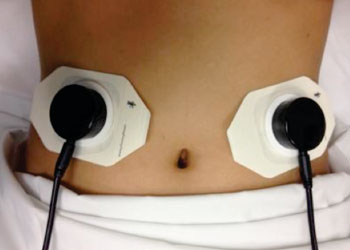Acoustic Biosensor Assesses Feeding Safety Following Surgery
By HospiMedica International staff writers
Posted on 20 Aug 2014
A novel disposal listening device that attaches to the abdomen could help monitor digestion in postoperative patients. Posted on 20 Aug 2014
The acoustic gastrointestinal surveillance (AGIS) device, developed by researchers at the University of California, Los Angeles (UCLA, USA), is a noninvasive biosensor resembling a small plastic cap (with a tiny microphone inside) that can detect paralytic postoperative ileus (POI), a malfunction of the intestines. Using the sensor, researchers can monitor sounds emanating from the intestines and measure the rate of acoustic events (i.e., movements) as they occur. In a study, The researchers compared intestinal rates of 7 healthy subjects by using the device for 60 minutes (after a standardized meal) to rates recorded in two postoperative groups, 8 patients who were tolerating food, and 25 that had POI.

Image: The acoustic gastrointestinal surveillance (AGIS) device (Photo courtesy of UCLA).
The results showed that the AGIS separated patients from controls with 100% sensitivity and 97% specificity. According to the researchers, using the AGIS may improve surgical outcomes, decrease healthcare costs, and shorten hospital stays. The device could also be used to help diagnose irritable bowel syndrome and inflammatory bowel disease (IBD), in addition to helping obese people learn by the sounds from their gut when they should or shouldn't eat to help them lose weight. The study was published on August 5, 2104, in the Journal of Gastrointestinal Surgery.
“The way doctors currently monitor for POI is putting a stethoscope on the patient's belly for 15 seconds, briefly listening for sounds of intestinal awakening, and asking about flatulence. It's all very rudimentary and inaccurate,” said lead author Prof. Brennan Spiegel, MD. “In the future, doctors may use the biosensor to determine which patients can be fed, making an evidence-based decision instead of just guessing based on less specific information.”
“The biosensor system is… a low-cost instrument that serves an unmet need for continuous, noninvasive monitoring of the human digestive processes,” added coauthor Professor of electrical engineering William J. Kaiser, PhD, co-director of the UCLA Wireless Health Institute. “The potential for this biosensor has been thrilling, since it will serve many applications from monitoring of POI to a wide range of digestive process diagnostic applications. The biosensor can operate in the clinic, at home, and at any location on the globe.”
POI refers to obstipation and intolerance of oral intake due to nonmechanical factors that disrupt the normal coordinated propulsive motor activity of the gastrointestinal tract following abdominal or non-abdominal surgery. There is general consensus that some degree of POI is a normal obligatory and physiologic response to abdominal surgery, and is generally a benign condition that resolves without serious consequences. However, when POI is prolonged, it leads to patient discomfort, dissatisfaction, and prolonged hospitalization, and must be differentiated from mechanical bowel obstruction or other postoperative complications.
Related Links:
University of California, Los Angeles














